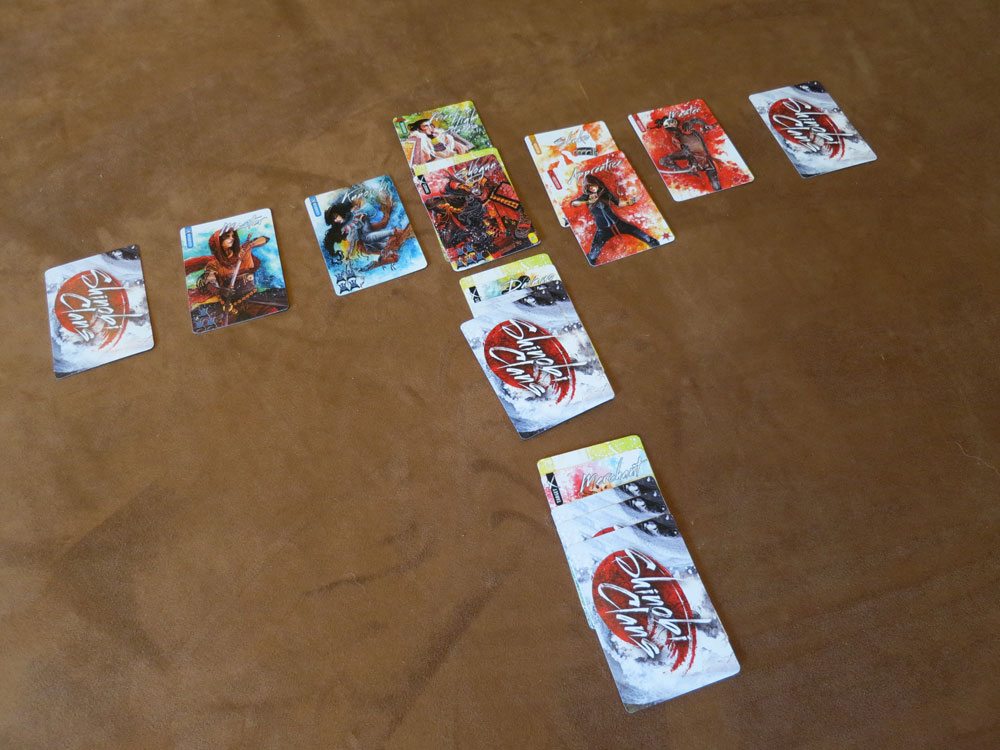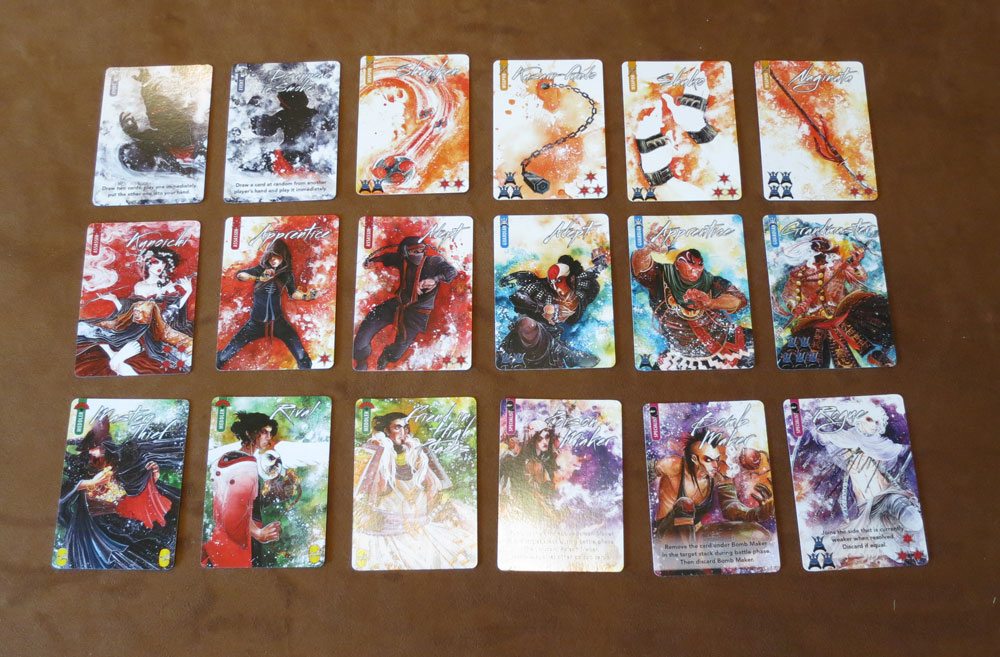
In geek culture, ninjas and pirates have always been held in a unique position of admiration; their mercenary existences dedicated to creating subterfuges that upset the status quo, while maintaining their own codes of honor. They are romantic in their own rights and we honor them with movies, books, and even “Talk Like a Pirate Day,” a type of holiday that would be lost on the silent ninja. But where the pirate has been honored with lots of great board games, the ninja has been more or less left behind. There have been few really good ninja-based games … until now.
Shinobi Clans is an upcoming card drafting game from designer Jürgen Mayer and publisher Posthuman Studios. I had a chance to meet Mayer and play the game at Gen Con this year and it’s definitely worth checking out.
The game I played was a print-to-play version, so components weren’t great, but Mayer assured me they will be much better when the game releases. Still, the art on the cards is breathtaking. All original art by the illustrator NEN really helps to create a great atmosphere for the game and the cards are so nice, you may find yourself just staring at them instead of planning your turn.
There are six types of cards. Guardian cards represent resources that can protect a target and Assassins are resources used to, you guessed it, assassinate targets. Specialists are used to help either assassins or guardians and Weapons cards can also affect either faction. There are Meddlers who can affect the reward for a contract, adding to or taking away from the reward. And, finally, there are Event cards which have an immediate one-time effect.
Each class of card has a unique color scheme, but also other unique identifiers so if you have trouble seeing color, you can readily classify the card. Additionally, the bottom of most cards has a number of helmets or shurikens to show the power of the card in assisting Guardians (helmets) or Assassins (shurikens). Cards that can be used by either side have a mixture of helmets and shurikens. Meddlers have gold tokens indicating how they effect the reward and some cards only have text, which explains their effects.

As you prepare to “strike with style” (the game’s slogan), you’ll want to gather a few friends since the game is for three to five players above the age of 13, and block out about an hour. The game plays in three rounds of five phases, each round taking about 15-20 minutes.
For game setup, each player gets a set of 10 contract tokens, which feature each of the game’s five targets, with two options for each — guardian or assassination. Reward and target cards are removed from the deck and the remaining battle deck is shuffled in preparation for battle.
During the first phase of each round, three targets are randomly drawn and placed face up from the five target cards. Additionally, three rewards are randomly drawn and placed face down beneath each of the targets. Four targets and rewards are used for a five player game.
The second phase is the drafting phase, where players select the ninjas and resources they want to create their clan. First, cards are dealt face down to each player — four in the first round, two in the second, and none in the third and final round. Cards are then drafted by dealing six face down cards to each player (and eight in the second round, ten in the last round). Players hold their drafting deal separate from their initial cards, so they can select a single card then pass the set, taking a single card from each passed set until a hand of ten cards is achieved. No player can have more than 10 cards heading into the third, contract, phase. There are also advanced drafting rules for experienced players, which won’t be covered here.
As players prepare for the third phase, they look at the targets and decide if they want to attempt to guard or assassinate the targets. Each player then chooses two contract tokens and sets them aside. Each chosen token should represent one of the three targets and can be any combination of guarding and assassinating, with the exception that a player cannot both guard and assassinate the same target.
In the fourth phase, the stealthy ninja phase, players take turn playing battle cards on targets. With the exception of event cards, battle cards are placed face down on the targets. Weapons are played face down to the left or right of the target; these areas are known as the battle slots. Playing weapon cards early may potentially give away your intentions, so there is an element of bluffing and deduction during this phase. Event cards are played away from the target and battle slots, resolved and discarded. Players can also pass during the ninja phase, holding cards for the next round.
Once all players are finished playing cards, the final phase, the Battle phase, begins. One at a time, a target is resolved. This is done by first revealing the players who selected that target with their contract tokens. Battle cards are flipped over one at a time and resolved. Guardian cards are placed in battle slots to the left of the target and assassins are placed to the right. Only a single ninja can occupy a battle slot, but if there is a weapon in a slot, the ninja is placed on top of the weapon card and the weapon’s power is used to augment the ninja’s power. Any Specialist cards are resolved and Meddlers are placed beneath the Target’s reward.
Beginning with the inside and working out, resolve the battle slots. (The first card to the immediate left and right of the target is battle slot one and each of the ninjas in those slots battle each other.) Some ninjas have the ability to remove the opposing ninja, the opposing weapon, or other effects. Once these cards have been resolved, all of the Guardian power helmets are added (including the target’s defensive helmet power) and compared to the opposite side’s shurikens. If helmets are more numerous, the target survives and the Guardians win. If there are more shurikens, the target has been killed and the Assassins win.
The contract is resolved by taking the target’s gold value, adding the reward value and adding or subtracting any Meddler effect and dividing the total pot for the target amongst the winning ninjas for that target. Play then moves to the next target; the winner is the player with the most gold at the end of the game.
Shinobi Clans is a really fun strategic card game that will have you thinking (and quite probably overthinking) about every card you play. There are plenty of cards and the powers on them are different enough that each round and game feels unique. Because you will have seen most of the cards in play during the drafting phase, you’ll find yourself worrying about who has specialist cards and what target they will be played on. Did your opponent play the weapon in a feint or is he really trying to assassinate the target? What’s more, contract selection is an important process. If you select a target no one else has chosen and you win, you get all the gold.
The result is a game where the play unfolds in a manner you hardly ever expect and a final card may turn the tide of the round or even the game. It’s very good fun and worth putting on your game radar. While there are a few things I didn’t like about the cards (it’s difficult to see the powers on some cards because of colors running together) the designer assured me this would be fixed in the final version.
Shinobi Clans is scheduled to be released in late 2013, retailing for around $25, and its early limited run completely sold out very quickly at Gen Con. When it makes it way into your FLGS later this year, be sure to slink silently in and check it out.

Disclosure: GeekDad received a sample of this product.


